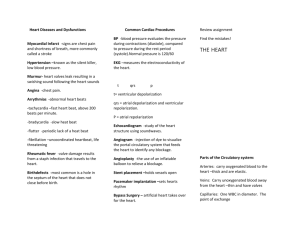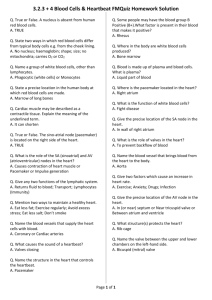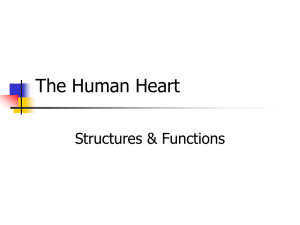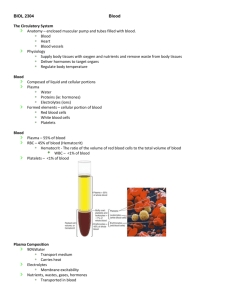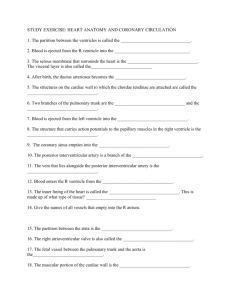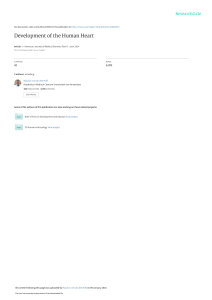Heart
advertisement
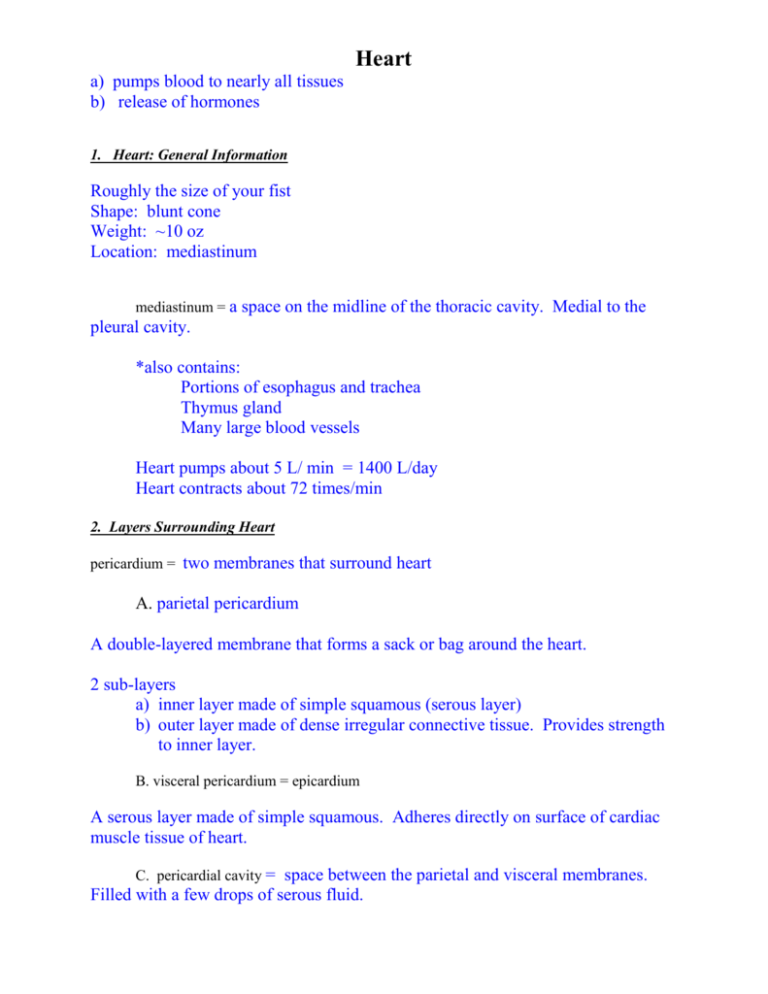
Heart a) pumps blood to nearly all tissues b) release of hormones 1. Heart: General Information Roughly the size of your fist Shape: blunt cone Weight: ~10 oz Location: mediastinum mediastinum = a space on the midline of the thoracic cavity. Medial to the pleural cavity. *also contains: Portions of esophagus and trachea Thymus gland Many large blood vessels Heart pumps about 5 L/ min = 1400 L/day Heart contracts about 72 times/min 2. Layers Surrounding Heart pericardium = two membranes that surround heart A. parietal pericardium A double-layered membrane that forms a sack or bag around the heart. 2 sub-layers a) inner layer made of simple squamous (serous layer) b) outer layer made of dense irregular connective tissue. Provides strength to inner layer. B. visceral pericardium = epicardium A serous layer made of simple squamous. Adheres directly on surface of cardiac muscle tissue of heart. C. pericardial cavity = space between the parietal and visceral membranes. Filled with a few drops of serous fluid. 3. Layers of the Heart Wall - 3 layers: A. visceral pericardium = epicardium A serous membrane made of simple squamous. Forms the smooth outer layer of the heart. B. myocardium Made of cardiac muscle tissue. Contracts to pump blood. Thickest of the 3 layers. C. endocardium Made of simple squamous but not a serous layer. Forms the smooth inner lining of heart. 4. External Anatomy of Heart * 9 major blood vessels at base of heart artery = a blood vessel that carries blood AWAY from heart vein = a blood vessel that carries blood TOWARD heart. A. two arteries 1. pulmonary trunk Exits from R. Ventricle Quickly splits into L & R Pulmonary arteries Sends deoxygenated blood to lungs 2. aorta Exits from L. Ventricle. Biggest and strongest blood vessel in body. Sends Oxygenated blood to body tissues. B. seven veins 1. superior vena cava brings deoxygenated blood to right atrium from upper body. 3. coronary sinus brings deoxygenated blood to right atrium from heart. 2. inferior vena cava 4. pulmonary veins brings deoxygenated blood to the right atrium from lower body gas (4 total) brings oxygenated blood to the left atrium from lungs following exchange. 5. Internal Anatomy of Heart * 4 blood-filled spaces called chambers * 2 on left of heart; 2 on right of heart A. atria Two superior chambers of the heart. Have relatively thin myocardium Separated from one another by a muscular wall Interatrial septum Receives blood from 7 major veins: Right: -superior vena cava -inferior vena cava -coronary sinus Left: 4 pulmonary veins B. ventricles = two inferior chambers - have relatively thick myocardium, especially the Left Ventricle. -separated from one another by a muscular wall (interventricular septum) -sends blood into 2 major arteries. Right Pulmonary Trunk Left Aorta C. heart valves 2 sets of valves in heart Made of folds of endocardium and reinforced with connective tissue. Function: maintain a one-way flow of blood inside heart. 1) atrioventricular (AV) valves Location: between an atrium and a ventricle Right AV valve has 3 cusps (folds) so it is called the TRICUSPID valve. Left AV valve has 2 cusps, so it is called the BICUSPID valve (mitral valve) 2) semilunar valves Location: between a ventricle and artery that exits it. Right semilunar valve has 3 cusps (pulmonary semilunar valve) Left semilunar has 3 cusps (aortic semilunar valve) http://abcnews.go.com/WNT/video/dr-oz-performs-heart-surgery-ny-med-16751258 Heart Dissection Lab - http://www.youtube.com/watch?v=_h-GbyMl0o&feature=player_embedded 6. Conduction System of Heart A series of highly specialized cardiac muscle cells. Function: to initiate and distribute an action potential to entire myocardium. http://www.youtube.com/watch?v=bxKBQqe_Bo0 https://highered.mcgrawhill.com/sites/0072495855/student_view0/chapter22/animation__conducting_system_of_ the_heart.html http://education-portal.com/academy/lesson/heartbeat-and-heart-contractioncoordination.html#lesson A. SA node = pacemaker Located in the wall of the Right Atrium Function: a) spontaneously initiate an Action Potential b) Send Action Potential to entire atrial myocardium. Results in contraction of both atria. B. AV node Located in the interatrial septum Function: send the Action Potential inferiorly into the ventricular myocardium. C. AV bundle A short segment of conduction tissue located in the interventricular septum Splits into: left and right bundle branches. Both bundle branches continue inferiorly in septum to apex. D. conduction myofibers = Purkinje fibers As L & R bundle branches arrive at apex, they both curve superiorly. Give off hundreds of small branches (Purkinje fibers) Function: delivers the AP to entire ventricular myocardium Result: Contraction of both Ventricles. 7. Regulation of heart rate - SA node initiates heart beat, but several factors can influence the SA node A. nervous control of heart rate Recall: medulla oblongata has many involuntary control centers. cardiovascular center in medulla oblongata -receives a variety of sensory information concerning BP and )2 content of blood -based upon current info, cardiovascular center can 1. stimulate SA node via sympathetic neurons ( inc heart rate) 2. Inhibit SA node via parasympathetic neurons (dec heart rate) B. chemical control of heart rate 1. hormones There are several hormones that can influence heart rate but there are 2 hormones: Epinephrine and norephinephrine (from adrenal medulla) Accentuate the “fight or flight” response Both hormones stimulate SA node and thus increase heart rate. 1. ions 3 major ions can influence heart rate. A) calcium. Stimulates SA node (INC HR) B) Potassium & Sodium. Inhibit SA node (DEC HR) (potassium is used as part of lethal injections!) 8. Disorders of the heart A. myocardial infarction = “heart attack” Infarction = the death of a small patch of myocardium due to an interrupted blood flow. Usually results from a blockage in the coronary arteries or their branches. Lead to partial or total stoppage of heart contractions. Symptoms: (these are different in men and women) Pain in chest, left arm or jaw. Dizziness, shortness of breath. Dead myocardium is replaced by non-contracting scar tissue. Treatment: bypass surgery, heart transplant B. coronary artery disease The left and Right coronary arteries are the first two branches off the aorta and supply oxygenated blood to the heart itself. Based upon lifestyle or genetics, these blood vessels can become blocked or clogged with cholesterol This reduces blood flow to a small patch of myocardium. Can lead in time to a heart attack Treatments: drugs, angioplasty (balloon) http://www.youtube.com/watch?v=S9AqBd4RExk
